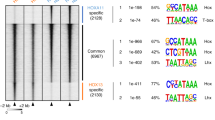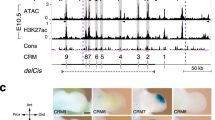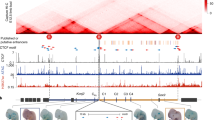Abstract
Hox genes, located at one end of the HoxD cluster, are essential for the development of the extremities of our limbs; that is, the digits. This ‘collinear’ correspondence is accompanied by a gradual decrease in the transcriptional efficiency of the genes. To decipher the underlying regulatory mechanisms, and thus to understand better how digits develop, we engineered a series of deletions and duplications in vivo. We find that HoxD genes compete for a remote enhancer that recognizes the locus in a polar fashion, with a preference for the 5′ extremity. Modifications in either the number or topography of Hoxd loci induced regulatory reallocations affecting both the number and morphology of digits. These results demonstrate why genes located at the extremity of the cluster are expressed at the distal end of the limbs, following a gradual reduction in transcriptional efficiency, and thus highlight the mechanistic nature of collinearity in limbs.
This is a preview of subscription content, access via your institution
Access options
Subscribe to this journal
Receive 51 print issues and online access
$199.00 per year
only $3.90 per issue
Buy this article
- Purchase on Springer Link
- Instant access to full article PDF
Prices may be subject to local taxes which are calculated during checkout






Similar content being viewed by others
References
Rijli, F. M. & Chambon, P. Genetic interactions of Hox genes in limb development: learning from compound mutants. Curr. Opin. Genet. Dev. 7, 481–487 (1997)
Dolle, P., Izpisua-Belmonte, J. C., Falkenstein, H., Renucci, A. & Duboule, D. Coordinate expression of the murine Hox-5 complex homoeobox-containing genes during limb pattern formation. Nature 342, 767–772 (1989)
Davis, A. P., Witte, D. P., Hsieh-Li, H. M., Potter, S. S. & Capecchi, M. R. Absence of radius and ulna in mice lacking hoxa-11 and hoxd-11. Nature 375, 791–795 (1995)
Fromental-Ramain, C. et al. Specific and redundant functions of the paralogous Hoxa-9 and Hoxd-9 genes in forelimb and axial skeleton patterning. Development 122, 461–472 (1996)
Tabin, C. J. Retinoids, homeoboxes, and growth factors: toward molecular models for limb development. Cell 66, 199–217 (1991)
Duboule, D. How to make a limb? Science 266, 575–576 (1994)
Johnson, R. L., Riddle, R. D. & Tabin, C. J. Mechanisms of limb patterning. Curr. Opin. Genet. Dev. 4, 535–542 (1994)
Dolle, P., Izpisua-Belmonte, J. C., Brown, J. M., Tickle, C. & Duboule, D. HOX-4 genes and the morphogenesis of mammalian genitalia. Genes Dev. 5, 1767–1767 (1991)
Fromental-Ramain, C. et al. Hoxa-13 and Hoxd-13 play a crucial role in the patterning of the limb autopod. Development 122, 2997–3011 (1996)
Zakany, J., Fromental-Ramain, C., Warot, X. & Duboule, D. Regulation of number and size of digits by posterior Hox genes: a dose-dependent mechanism with potential evolutionary implications. Proc. Natl Acad. Sci. USA 94, 13695–13700 (1997)
Duboule, D. Vertebrate Hox genes and proliferation: an alternative pathway to homeosis? Curr. Opin. Genet. Dev. 5, 525–528 (1995)
Duboule, D. & Morata, G. Colinearity and functional hierarchy among genes of the homeotic complexes. Trends Genet. 10, 358–364 (1994)
Herault, Y., Fraudeau, N., Zakany, J. & Duboule, D. Ulnaless (Ul), a regulatory mutation inducing both loss-of-function and gain-of-function of posterior Hoxd genes. Development 124, 3493–3500 (1997)
Peichel, C. L., Prabhakaran, B. & Vogt, T. F. The mouse Ulnaless mutation deregulates posterior HoxD gene expression and alters appendicular patterning. Development 124, 3481–3492 (1997)
Spitz, F. et al. Large scale transgenic and cluster deletion analysis of the HoxD complex separate an ancestral regulatory module from evolutionary innovations. Genes Dev. 15, 2209–2214 (2001)
van der Hoeven, F., Zakany, J. & Duboule, D. Gene transpositions in the HoxD complex reveal a hierarchy of regulatory controls. Cell 85, 1025–1035 (1996)
Kmita, M., van Der Hoeven, F., Zakany, J., Krumlauf, R. & Duboule, D. Mechanisms of Hox gene colinearity: transposition of the anterior Hoxb1 gene into the posterior HoxD complex. Genes Dev. 14, 198–211 (2000)
Herault, Y., Beckers, J., Gerard, M. & Duboule, D. Hox gene expression in limbs: colinearity by opposite regulatory controls. Dev. Biol. 208, 157–165 (1999)
Herault, Y., Rassoulzadegan, M., Cuzin, F. & Duboule, D. Engineering chromosomes in mice through targeted meiotic recombination (TAMERE). Nature Genet. 20, 381–384 (1998)
Duboule, D. Patterning in the vertebrate limb. Curr. Opin. Genet. Dev. 1, 211–216 (1991)
Dolle, P. et al. Disruption of the Hoxd-13 gene induces localized heterochrony leading to mice with neotenic limbs. Cell 75, 431–441 (1993)
Davis, A. P. & Capecchi, M. R. A mutational analysis of the 5′ HoxD genes: dissection of genetic interactions during limb development in the mouse. Development 122, 1175–1185 (1996)
Kmita, M., Kondo, T. & Duboule, D. Targeted inversion of a polar silencer within the HoxD complex re-allocates domains of enhancer sharing. Nature Genet. 26, 451–454 (2000)
Nelson, C. E. et al. Analysis of Hox gene expression in the chick limb bud. Development 122, 1449–1466 (1996)
Kondo, T., Zakany, J. & Duboule, D. Control of colinearity in AbdB genes of the mouse HoxD complex. Mol. Cell 1, 289–300 (1998)
Goff, D. J. & Tabin, C. J. Analysis of Hoxd-13 and Hoxd-11 misexpression in chick limb buds reveals that Hox genes affect both bone condensation and growth. Development 124, 627–636 (1997)
Foley, K. P., Engel, J. D. . Individual stage selector element mutations lead to reciprocal changes in β- vs. ɛ-globin gene transcription: genetic confirmation of promoter competition during globin gene switching. Genes Dev. 6, 730–744 (1992)
Herault, Y., Beckers, J., Kondo, T., Fraudeau, N. & Duboule, D. Genetic analysis of a Hoxd-12 regulatory element reveals global versus local modes of controls in the HoxD complex. Development 125, 1669–1677 (1998)
Kmita, M., Tarchini, B., Duboule, D. & Herault, Y. Evolutionnary conserved sequences are required for the insulation of the vertebrate HoxD complex in neural cells. Development 129, 5521–5528 (1976)
Wijgerde, M., Grosveld, F. & Fraser, P. Transcription complex stability and chromatin dynamics in vivo. Nature 377, 209–213 (1995)
Dillon, N., Trimborn, T., Strouboulis, J., Fraser, P. & Grosveld, F. The effect of distance on long-range chromatin interactions. Mol. Cell 1, 131–139 (1997)
Tanimoto, K., Liu, Q., Bungert, J. & Engel, J. D. Effects of altered gene order or orientation of the locus control region on human beta-globin gene expression in mice. Nature 398, 344–348 (1999)
Vidal, F., Sage, J., Cuzin, F. & Rassoulzadegan, M. Cre expression in primary spermatocytes: a tool for genetic engineering of the germ line. Mol. Reprod. Dev. 51, 274–280 (1998)
Herault, Y., Hraba-Renevey, S., van der Hoeven, F. & Duboule, D. Function of the Evx-2 gene in the morphogenesis of vertebrate limbs. EMBO J. 15, 6727–6738 (1996)
Inouye, M. Differential staining of cartilage and bone in fetal mouse skeleton by alcian blue and alizarin red. S. Cong. Anom. 16, 171–173 (1976)
Acknowledgements
We thank M. Friedli for technical assistance, and J. Zakany and other colleagues from the Duboule laboratory for sharing mice, reagents, discussions and comments on the manuscript. This work was supported by funds from the Canton de Genève, the Swiss National Research Fund, the Claraz, Latsis, Cloetta and Louis-Jeantet foundations, as well as the NCCR Frontiers in Genetics.
Author information
Authors and Affiliations
Corresponding author
Ethics declarations
Competing interests
The authors declare that they have no competing financial interests.
Rights and permissions
About this article
Cite this article
Kmita, M., Fraudeau, N., Hérault, Y. et al. Serial deletions and duplications suggest a mechanism for the collinearity of Hoxd genes in limbs. Nature 420, 145–150 (2002). https://doi.org/10.1038/nature01189
Received:
Accepted:
Issue Date:
DOI: https://doi.org/10.1038/nature01189
This article is cited by
-
Heterogeneous combinatorial expression of Hoxd genes in single cells during limb development
BMC Biology (2018)
-
Transcriptomic insights into the genetic basis of mammalian limb diversity
BMC Evolutionary Biology (2017)
-
A genome-wide association study identifies a genomic region for the polycerate phenotype in sheep (Ovis aries)
Scientific Reports (2016)
-
Evolution of Hoxa11 regulation in vertebrates is linked to the pentadactyl state
Nature (2016)
-
Generation of an 870 kb deletion encompassing the Skt/Etl4 locus by combination of inter- and intra-chromosomal recombination
BMC Genetics (2015)
Comments
By submitting a comment you agree to abide by our Terms and Community Guidelines. If you find something abusive or that does not comply with our terms or guidelines please flag it as inappropriate.



